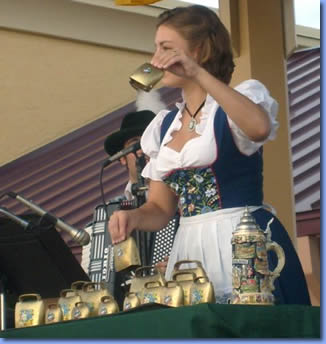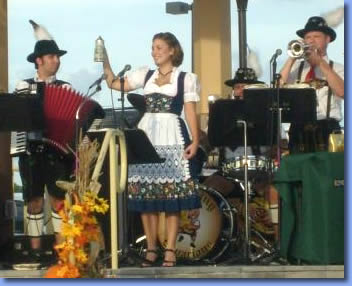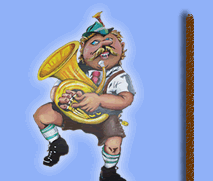Cowbells
Cowbells, also known as Alpine bells, are brass bells with different pitches. Austrian cowbells originally were worn by herded animals like cows and sheep and tuned differently to distinguish different animals. We have spent a long time wandering through the Alps to obtain all the correct pitches from different cows to play lovely music for you on the cowbells. (Shhhh….don’t tell the cows who took them!)

Yodeling
Singing by switching back and forth between the chest voice and a falsetto (head voice). According to the Oxford English Dictionary, the word yodel is from a German word jodeln (originally Bavarian) meaning “to utter the syllable jo.” It was thought to be a method of communicating between mountain peaks in the Swiss Alps and then became a part of the traditional music. Places with echoes are the best places for yodeling, gorges, mountains, lakes, empty amphitheatres, hallways, or most conveniently, your bathroom. “Singing in the shower” is highly overrated; soon everyone will switch to “Yodeling in the Shower.” Yo-del-ay-ee-hoo……
Bavarian Food
Many people have eaten some of the lunch and dinner favorites of Germany at Oktoberfests, such as bratwurst, sauerkraut, potato pancakes, schnitzel, or spaetzle. Most even have had the wonderful Black Forest cake for dessert. But, very few know a classic Bavarian breakfast dish. The band happens to have a favorite one, and luckily it can be found right here in the United States, the band’s favorite is a Bavarian Cream Donut. (Tip: If you intend to wake the band up early in the morning, come prepared with at least a dozen Bavarian Cream Donuts and you will survive to tell the tale.)
Tracht (Attire)
Men: The traditional Bavarian attire for men are Lederhosen, leder meaning leather and hosen meaning pants, together that is leather pants. The suspenders actually serve to hold them up. With lederhosen, they wear hats with either a feather or goat hair. On the hats, they collect pins of where they have been or things that they like. They also wear wool socks and funny wool pieces on their calves called Stutzen. The story goes that when wool was scarce, instead of making long socks, to conserve wool, they covered the most important parts, the foot itself and a piece to cover the calf muscle. Since Florida is a slightly different temperature than the Alps, the wool is not necessary to keep the calf muscles warm, however the guys in the band still wear them for their fashionable style.
Women: The traditional Bavarian attire for women are dirndls. These are dresses that may be short, knee length, or long. They are usually worn with a separate blouse and apron. Women might also wear jewelry such as an Edelweiss necklace or earrings with them. In full Tracht, the women also have hats that are slightly smaller than the men’s with smaller feathers on them. They also wear a shawl over the shoulders and chains hook across the front of the dirndl. For decoration they may also wear flowers in the front of the blouse. Dancers wear dirndls with more material in the skirt so it spins nicely when they dance (they also wear bloomers under them, so no peeking!)
How to Polka Dance
Guys:
1. Take your partner’s hand – left hand out and right hand behind her back
2. Start with your left foot and step: Left, Right, Left, Hold
3. Then step: Right, Left, Right, Hold
4. Continue throughout the polka, moving in small circles
5. At the end of the polka, clap for the Band and drink a beer
If this is too complicated, you haven’t had enough beer, have another and then jump a lot with a big smile on your face and no one will ever notice! (Tip: Try not to step on your partner’s feet)
Ladies:
1. Take your partner’s hand – right hand out and left hand behind his back
2. Start with your right foot and step: Right, Left, Right, Hold
3. Then step: Left, Right, Left, Hold
4. Continue throughout the polka, moving in small circles
5. At the end of the polka, clap for the Band and drink a beer
If this is too complicated, just place your right foot on his left and your left foot on his right and dance on his feet (this also prevents him from stepping on yours! (Tip: Smile big and no one will notice)
How to Chicken Dance
1. Put your hands up in front of you
2. Make little alligator mouths with both hands, and make them chew
3. Flap your wings like a chicken
4. Wiggle with a twist to the floor
5. Clap your hands 4 times
6. Repeat
When the music changes, take your partner’s elbow with your elbow and go around in a circle. Switch directions a few times. The more you skip and smile, the better this looks! (Tip: You may cluck as well…after all this is the “Chicken Dance”)
Where is Bavaria?
Bavaria (Bayern) is the largest “state” in Germany (by area). It is located in the southeast region of Germany. It is bordered by Austria, the Czech Republic and Switzerland. The Bavarian Alps define its border with Austria. Munich (München) in Upper Bavaria is the capital of Bavaria.
Edelweiss
The Edelweiss is a small, white, fuzzy flower that grows high in the mountains of Germany (Alps) often precariously near the edges and cliffs. Young men would climb up to pick an Edelweiss and bring it back to the girl they were courting. Today the Edelweiss is a popular Bavarian symbol that is found on many different items, the girls in the German Band wear them on their necks and they are also embroidered on their dirndls. (Ask Starr if he retrieved an Edelweiss for Krissy yet)
Beer Drinking Songs – “Ein Prosit”
A very popular song at Oktoberfests is “Ein Prosit”. The traditional way to do this is to hold up whatever you’re drinking (probably a beer) high into the air and sing:
Ein Prosit, Ein Prosit, Der Gemütlichkeit
Ein Prosit, Ein Prosit, Der Gemütlichkeit
Usually followed by a German count off:
Eins, zwei, drei
Then possibly some hoy hoy hoys and then Prrrrost!
If you're not sure how it goes (how to pronounce the German), watch the band, they'll do it a few times!
The Above Defined
Ein Prosit = A prost
Der Gemütlichkeit = Well being and happiness enjoyed with good friends and good times
Eins, zwei, drei = One, Two, Three

Oktoberfest (Octoberfest)
They say Oktoberfests originated from a horse race honoring the marriage of Crown Prince Ludwig and Princess Therese in 1810, in Munich, Germany. From horse races it developed into more of a carnival atmosphere with beer tents, live music and dancing, and from a one day race to a month long festival. It began in Bavaria and now the rest of the world joins in!
Neuschwanstein Castle
Walt Disney modeled Sleeping Beauty’s Castle in Disneyland after the Neuschwanstein Castle in Bavaria. It also served as an inspiration (along with French castles) for Cinderella’s Castle. The beer steins that the girls in the band carry both have images of the Neuschwanstein Castle.
More Interesting Facts
The automobile makers BMW (Bayerische Motoren-Werke, or Bavarian Motor Works) and Audi, Siemens (electricity, telephones, medical instruments), Adidas and Puma had a Bavarian industrial base.
Many scenes from the musical The Sound of Music by Rodgers and Hammerstein were shot in the Bavarian Alps.

|
|





